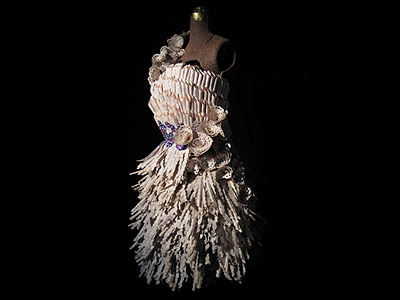
Visual artist Carrie Ann Schumacher was working at the Downers Grove Public Library one day three years ago, sorting through loads of donated books, when she came to a box unlike all the others.
Inside were 50 romance novels from the Harlequin Intrigue series, books with names like A Lieutenant’s Lady. Schumacher, a 2008 Elmhurst graduate who was working at the library on a break from her graduate studies in art at Northern Illinois University, knew the books were not the sort of thing the library could use. But her artist’s instincts told her not to toss the books.
“I didn’t know what I was going to do with them,” she said. “But I knew that if I didn’t take them, I’d wake up at 3 a.m. someday, kicking myself for not having them.”
Schumacher’s instincts proved prescient. Those unwanted romance volumes have become the basis of a truly novel body of art—one that has earned the young artist national attention.
Using little more than scrapbooking scissors, dressmakers’ frames, duct tape and hot glue, Schumacher has spent the last several years turning the pages of romance novels into astonishingly elegant wedding dresses. Her work offers a thought-provoking take on the optimism and illusion behind our matrimonial traditions, and it has earned Schumacher solo shows in galleries around the Midwest and media attention from WGN-TV and AOL News.
“I’d been thinking about the ideas sold to us as little girls about what it means to be a woman, about romance and beauty and fashion,” she said. Looking for ideas for a student exhibition at Northern Illinois, she realized that few artifacts express our cultural ambivalence about the feminine ideal quite like the wedding dress. Like the best romances, Schumacher’s dresses are beautiful, but also fragile and impractical and, well, paper-thin.
“They are not made to be worn,” says Schumacher, who married fellow artist and Elmhurst alum Bogumil Bronkowski last year. “I mean, you can take them off the dress forms, but to actually put one on would be pretty uncomfortable.”
Schumacher had no experience in fashion design or dressmaking, and her previous work in art school had been in painting and digital media.
“I don’t know what made me think I could do this,” she said of her dresses. “I’d always been a 2-D person.”
But after months of trial and all-too-frequent error, she began to master her one-of-a-kind craft. She found that using a hole-puncher on the strips of pages she cut from the books would lighten the dress and create a lacy effect. She learned to make paper florettes to accent necklines. She learned, as so many of us have, that duct tape will hold together just about anything.
Earlier this summer, Schumacher’s dresses were the subject of an exhibition at Chicago’s Harold Washington Library Center called, “Build Her a Myth: Romance Novel Dresses.” More solo shows are ahead, including ones at Claremont College in Ohio, the Jasper Arts Center in Indiana and Buckham Gallery in Flint, Michigan.
Schumacher said she has sold several of her dresses, for between $1,500 and $3,000. One of her biggest fans is an English romance novelist who contacted Schumacher to tell her that she loved what she had done with her books.
The original cache of 50 books long since exhausted, Schumacher now hunts for romance novels in thrift stores. (They remain only raw material for her; she has not become a romance-novel reader.) She orders her dress forms online. When one gallery-goer asked why Schumacher’s dresses were sized for the hyper-petite and why there were no plus-size paper wedding dresses, her response was simple and practical. For a young, budget-conscious artist who has to transport her own work across country, the smallest dress forms offer the lightest and least expensive option.
When Schumacher married last year, friends urged her to make her own romance-novel dress for the occasion. But the artist selected a more conventional dress. Paper, she said, would have been impractical.
“We’re Catholic; we have all kinds of candles and fire going,” she said.
When it rained heavily on her wedding day, Schumacher felt vindicated.
“I was so thankful [she wasn’t wearing one of her of her own creations],” she said. “That dress would have melted.”














